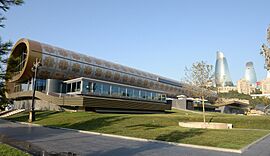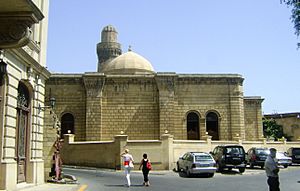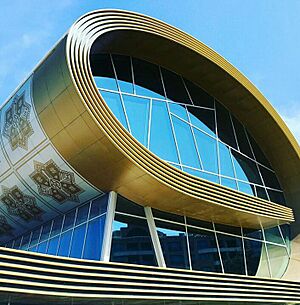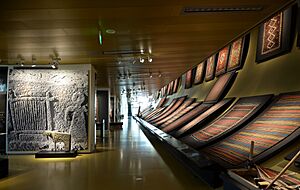Azerbaijan Carpet Museum facts for kids
 |
|
| Established | 1967 |
|---|---|
| Location | Mikayil Huseynov Street 28, Baku, Azerbaijan |
| Type | Museum |
| Public transit access | Add→ Icheri Sheher metro station |
The Azerbaijan National Carpet Museum (Azerbaijani: Azərbaycan Milli Xalça Muzeyi) is a special place in Baku, Azerbaijan. It shows off beautiful Azerbaijani carpets and rugs. You can see how they were made long ago and how they are made today. This museum has the biggest collection of Azerbaijani carpets in the whole world! It first opened in 1967 and moved to a cool new building by the sea in 2014.
Contents
History of the Museum
The museum started in 1967. Its first home was in the Juma Mosque in Icheri Sheher, which is a very old part of Baku. This mosque was built in the 1400s and fixed up in the 1800s. The museum's first show was in 1972.
Later, in 1992, the museum moved to a different building. This building is now called the Baku Museum Center. The museum's collection was named after a famous carpet designer named Latif Karimov.
Plans for a brand new building started in 2010. The new building was finished and opened on August 26, 2014. It was then called the Azerbaijan Carpet Museum.
What the Museum Aims To Do
The main goals of the Azerbaijan National Carpet Museum are important. They want to find, keep safe, study, show, and share amazing examples of carpet art. This art is a big part of Azerbaijan's national history and culture.
How the Collection Grew
Since 1967, the museum has been able to get more and more carpets. They bought handmade items from people and from craft groups. Some of the most beautiful Azerbaijani carpets were bought for the museum during these years. The government helped by giving money to buy new items and to go on trips to find more. Latif Karimov led this important work.
Many smart people helped build the museum's collection. These included scholars like Rasim Afandiyev and Roya Taghiyeva. They helped the museum get old carpets, other carpet items, embroidery, metal art, traditional clothes, and jewelry. The Azerbaijan National Academy of Sciences also gave the museum old items found from long ago.
Over time, the museum also added works by artists from today. These include carpet artists, sculptors, and jewelers. The museum has grown into a very important place for keeping Azerbaijan's culture safe.
The museum has collected many items from different parts of Azerbaijan. It has the richest and most varied collection of Azerbaijani carpets. The museum now holds over 10,000 items! These include different types of carpets, metal art, textiles, costumes, and jewelry. Some items are from the Bronze Age, which is super old! Most of the collection is from the 1600s to the 1900s.
After Azerbaijan became independent, the Heydar Aliyev Foundation and the Ministry of Culture gave valuable items to the museum. People from all over the world also gave carpets to the museum. For example, in 2013, Beverly Schiltz gave two valuable Azerbaijani carpets. One was a Salyan Khilasi carpet from the 1800s. The other was an Ajdahali (Dragon) carpet from the late 1600s.
In 2017, for the museum's 50th birthday, a rare embroidery from the 1700s was bought and given to the museum. Also in 2017, a U.S. citizen named Elshad Tahirov bought a Baghchada Gullar carpet and gave it to the museum. The museum also bought a Shamakhi carpet from the late 1600s to early 1700s.
In 2018, the Heydar Aliyev Foundation gave two very valuable carpets from the 1600s, called Khatai and Nakhchivan carpets. An Italian collector, Mirco Cattai, gave a Hajigayib carpet from the 1800s. The museum also got two more carpets: a Sirt Chichi and a Khila Buta.
In 2019, the museum bought two old women's jewelry pieces from the 1800s. A Gonagkend carpet from the 1800s was given by Hillary-Dumas Jones and Jay Jones from the U.S.
In 2020, an Italian collector, Erminio Bottini, gave a Sor-sor carpet from 1811 to the museum.
In 2024, some unique art pieces were returned to Azerbaijan and given to the museum. People from Turkey, Italy, and Germany donated carpets from their collections. These included a Pashali kilim, Shikhli, Achma-Yumma, and Bahmanli carpets.
Visitors to the Museum
Today, the Azerbaijan National Carpet Museum is one of the most popular cultural places in Azerbaijan. Many people visit it every year. In 2016, about 60,000 people visited. In 2017, over 85,000 people came. By 2018, the number reached 110,000 visitors.
In 2019, the museum had a record-breaking 122,143 visitors! This made it the most visited museum in the country.
The museum also started special programs in 2019 to help people with disabilities visit. They share information about these programs with international museum groups. The museum's staff regularly hold workshops for people with disabilities.
All the descriptions in the museum are also in Braille for people who cannot see well. The museum even made special carpet samples that visually impaired people can touch. These samples let them feel the shapes of traditional carpet designs.
In 2020, the museum offered virtual tours with sign language for people who are deaf or hard of hearing. Visitors can also have a tour with a sign language interpreter. The museum is also easy for people using wheelchairs to move around. Labels and touchscreens are placed so they are easy to read and reach from a seated position.
After the COVID-19 pandemic, more people started visiting museums again. In 2022, the museum had 70,608 visitors, which was a big increase from 2021.
The Museum Building
The building itself is very unique. It is designed to look like a rolled-up carpet! An Austrian architect named Franz Janz designed it. It took over six years to build.
What You Can See in the Collection
The museum's collection has more than 10,000 items. These include old pottery, metal art from the 1300s, and jewelry from the Bronze Age. Of course, there are many carpets and carpet items from the 1600s to the 1900s. You can also see traditional clothes, embroidery, and modern art.
The museum offers talks and classes about carpets and art. It has a shop where you can buy books about Azerbaijani crafts and carpet art. The museum also has a special collection from the Shusha Museum of History. Some of these items were saved from Shusha before it was captured in 1992. They are now shown in an exhibit called "Burned Culture." In 2020, a Garagoyunlu carpet was added. In July 2022, the museum showed its newest item, a Lampa carpet made in Shusha in the 1930s.
International Exhibitions
The museum does a lot of research and helps the public learn. Every year, they organize exhibitions in Azerbaijan and other countries. They also print books about carpets. The museum has shown its collections in over 30 countries, including France, Germany, and Japan. For example, in 1998, the museum took part in a UNESCO exhibition in Paris. They showed carpets and folk art items like copper jugs and saddlebags.
|
See also
 In Spanish: Museo de Alfombra de Azerbaiyán para niños
In Spanish: Museo de Alfombra de Azerbaiyán para niños




